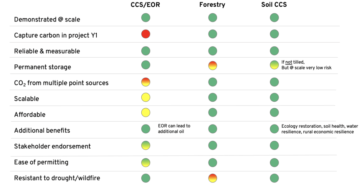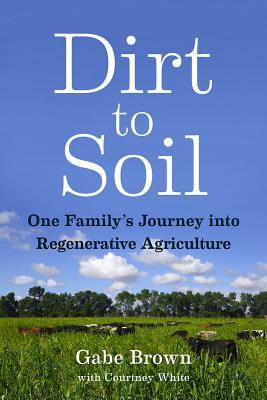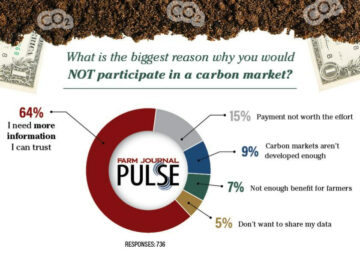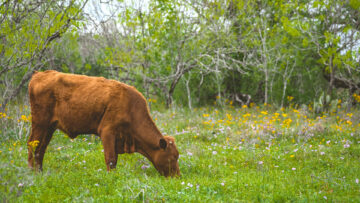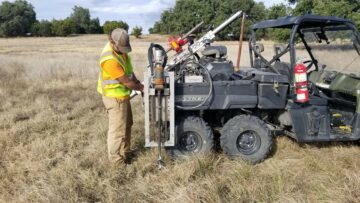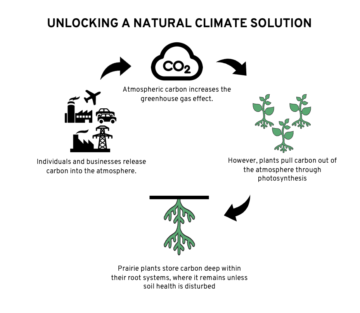
Watch the webinar to learn more about:
- How soil health impacts soil carbon storage
- A scientific perspective about how soil carbon stocks change over time and what this means for soil carbon storage permanence
[embedded content]
Transcript below provided by YouTube
Okay, I’m going to go ahead and kick things off welcome everybody my name is Megan Parks I am the Co-Founder and EVP at Grassroots Carbon, and thanks for joining us for the second in our series of educational webinars about soil carbon I want to invite everybody to follow us on social media because we will post these on YouTube when we’re done but you can also find out more about what we’re doing on LinkedIn Facebook Instagram and join in the conversation about what’s going on in the soil carbon storage world and you can also if you go on social media give us your suggestions for other topics that we can do and so since we don’t have very much time without further ado I’m going to introduce our speaker today I have with me um the privilege of talking with Dr. Jocelyn Lavallee who is a research scientist at Colorado State. We invited her to our discussion on permanence because she is an expert on soil carbon dynamics and controls on soil carbon permanence and she has a number of publications in this realm she likes to use a combination of continental data sets and targeted mechanistic experiments to advance the science in this field with uh the goal of improving understanding and predictions for soil carbon and nitrogen stocks into the future so jocelyn I want to get I want to waste no time and get right to it we’re here to talk about a key concept in the traditional carbon offset space which is the concept of permanence so the thing about carbon credits is that they are immortal and as we know with natural systems they’re constantly in flux so this idea is once you sequester the carbon how long will it stay there um and if it’s going to be re-released then we have a problem so I think that this concept is easier to understand when we talk when we think about technological carbon storage like carbon capture and sequestration I’m going to pump a CO2 molecule into some reservoir somewhere and lock it up into the into a vault forever like like putting something in a bank but um it seems to us that this type of thinking doesn’t really lend itself very well to nature-based carbon storage in things like forests and soils because they’re you know unlike uh technological solutions nature’s not a machine it’s a complex living system and carbon cycles through the system rather than being static so it’s more like entering into a partnership with a dynamic complex living system so what we’re trying to do is ensure that more carbon is kind of going into the system than the amount that’s being released so um with that in mind can you describe how carbon the carbon process works and how carbon cycles through soils yeah um so there’s a lot to say there but i’ll be you know as as general and brief as possible but basically you know when we’re thinking about soil carbon storage there’s two really main processes at play so the first is inputs those as we call them so things coming into the soil and that’s usually through plants um that’s the main input to soil carbon so plants are fixing carbon from the atmosphere through photosynthesis they’re sending it to their leaves and their roots and their root exodus right and and all of those things um enter the soil either by you know if it’s a leaf it falls off the plant it breaks down eventually if it’s a root it dies it turns over it it becomes still carbon and root exits tend to enter really fast um so that’s like the main input right to cell carbon and that’s the process where if you increase it or decrease it you might be have more or less coming in and then you have to think about the output from soil carbon so how it’s lost and that’s generally through microbial decomposition of that organic matter and so anything that increases or decreases the microbial decomposition rate is going to affect the size of that soil carbon pool as well so so really it’s this balance of inputs through through mostly plants and outputs through mostly microbial decomposition and how those two balance out each other and that’s going to determine whether the the soil carbon pool is growing or shrinking or staying the same right yeah I don’t know if that’s like enough I can go on why don’t you go on i’ll love to hear what you have to say yeah just I mean just a bit more about once that that carbon is in the soil what happens I mean basically it’s like you were talking about in the introduction it’s really dynamic and there’s a ton of stuff going on there’s there’s microbes eating it and building their own biomass and then dying there are soil animals eating those microbes um there are roots right turning over and exuding carbon and so there’s a ton of processes going on and when we measure soil carbon you know we’re sort of getting a snapshot of all of that but at any time you know one carbon molecule in the soil is is bouncing all around from all these different places and going through a lot of transformations so yeah it’s it’s quite a dynamic pool down there so this is really interesting because we’re in the business of working with farmers and ranchers and landowners to think about what are the kinds of practices in agriculture that can cause over time soil carbon stocks to increase or decrease and what can you do to improve soil organic matter in your soils and so one of the things that we’re doing when we work with certifiers to issue certified credits is where right now we only work with a certifier b carbon that requires soil measurements to quantify soil carbon stocks so we are taking meter deep soil measurements but i’ve seen that there’s other standards that require shallower measurements and there’s not a lot of consistency in this space so can you talk about um you know soil is not homogeneous through its depth right so is there a difference between the rates of exchange of carbon you know throughout the different depth layers or what are some of the dynamics that influence that yeah um it’s really important that question and that’s like you say it’s a big question right now in designing these protocols um there are huge differences in soils with depth and like you know if you’ve ever dug a pit you can tell just looking at the soil that it’s definitely very different from the top to the bottom and so in the top you know we think of that as a more dynamic zone you have roots growing there more prolifically you have you know more exchange with the atmosphere you usually have a lot more soil fauna and potentially more earthworms and things like that in the top layers so there’s usually just a lot more exchange going on there at depth um you know a lot of that sort of diminishes and the oxygenation diminishes as well so microbial and other animal activity is usually a bit lower just because there’s not as much oxygen sometimes not as much water it depends um and so the dynamics there are quite different and you know we’re really just starting to study this because like you say a lot of folks were just measuring say the top 15 centimeters or top 30 centimeters for a very long time um and part of that is just because it’s tough to get down deeper and it’s expensive um but now that we’re looking at it more we understand like okay this is a really big store of carbon it’s a really important store of carbon that can potentially last a bit longer than stuff in that topsoil um and it has sort of different it acts differently it has different controls on how long it stays there so you know maybe in that subsoil as we call it a lot of that permanence is determined by you know how the carbon reacts with mineral surfaces and with small tiny aggregates there that seems to be a really big control so things like that we’re realizing are quite different and if we don’t measure that carbon in the subsoil you know a we miss it for for accounting and b we are really not understanding you know a huge pool of carbon and how it behaves so um from a scientific perspective it’s really really important to measure it and kind of understand it um on its own and then from an accounting perspective you know especially as we try to do no-till and we try to plant deeper rooted crops you know we know it’s hugely important for carbon accounting so you know I would always as a scientist advocate that we measure it but obviously there’s logistic concerns and costs involved in that and so the question becomes you know can we measure it all the time if we can’t measure it all the time can we model it um or can we sort of extrapolate what we do know and so that’s that’s what everybody’s kind of grappling with right now indeed we know all about that is indeed very expensive but measurement right now is still the gold standard um so you know for rigor I think we’re stuck with it for the time being but there’s a lot going on around the margins on tech development sort of out of scope for this conversation probably but it’s really exciting really interesting yeah yeah really interesting um so another question that we get sometimes we get this question from companies that are looking to into purchasing soil carbon storage is you know they’re used to thinking about technological options and not so much nature and you know many of them are not natural scientists so they think there’s this perception that nature is very fragile and um you know forestry offsets have taken some criticism lately because a forest can burn down uh you know the tree and and they’re storing a lot of their carbon above ground in the biomass of the tree um what effect does fire have on the permanence of soil carbon stocks say in grasslands where where we’re working yeah I mean that’s a that’s a really interesting question and a pretty active area of research so the things that we think about when it comes to that question you know we do know that some of the obviously the carbon above ground most of it is lost right um as it burns and some of the carbon you know in roots and things below ground and in that that litter layer that’s on the top of the soil that tends to burn as well um however when that burns it forms what we call you know some people refer to it as biochar or pyrogenic carbon right just like the ashes in your fireplace and and so while that’s a fraction of the carbon that was there that carbon in that biochar or pyrogenic carbon is pretty long-lived and that’s like a really good example of a type of carbon that might actually remain in the soil for a long time because it’s hard to break down it’s pretty rare to find that but biochar is one example where it’s it does tend to stick around a bit longer so while on the short term you are losing a ton of carbon from your ecosystem on the long term the balance you know sort of shifts to accruing this longer lived carbon to some extent but since it’s a smaller fraction of what was there obviously you know if you’re accounting on a 10-year time scale and you’re considering that then then you do lose quite a lot of carbon if you have something like a fire if you’re thinking on a millennial scale you know it might chip the scales toward accruing it over time but but um for carbon markets that’s not really super relevant right indeed indeed geologic time versus human humanity time so that’s really interesting because I think it makes me think about um you know the natural flow of grassland ecosystems and how fire and grazers were all incorporated um and you know earth was doing this for a long time before we showed up and created carbon markets um and also that’s a good segue probably into a question about um whether permanence depends on the chemical structure of carbon so you mentioned that biochar is a longer-lived um carbon what else do you have to say about that does it last longer yeah and this is something that we brought up a bit earlier and there’s been a really nice article about it recently I think it’s called quantum magazine that i’d recommend um but just to say you know that for a long time what we thought controlled the permanence of carbon and soil we thought it was the chemical structure of that carbon and basically the more complex a molecule the longer it’s going to stay in the soil because it’s just hard for microbes to eat um and what we’ve realized is that that’s not really true like in general microbes can eat almost anything you give them I mean many of you have probably heard about you know oil spills and and spraying particular microbes on them to actually degrade that oil so we know that microbes can really eat almost anything and it’s also true with biochar like I have to say it’s not permanent nothing is permanent in soil um but there is evidence that it takes a bit longer you know on on a decadal or maybe a centurial time scale um to break down things like biochar so yeah it’s a tough one because actually getting the evidence to show whether a microbe is breaking down a particular molecule can be really hard and people are working on that with different you know phys like visual imaging techniques and things like that um and so our general understanding has shifted to knowing that it’s things other than the chemical structure but in some cases like with biochar it might help with it interesting I also saw that quanta article um really this is an article that came out in the last few days for all of you on the call in quantum magazine you can probably google it um and it talked about humus this idea of humus is possibly going going away and how scientists think about soil carbon but one thing that stuck with me from that article was I feel like they did use that same terminology of locking away molecules in a vault which I felt was unfortunate for those of us with a little bit more understanding of natural systems there’s more of a respiration going on so that seems like a missed opportunity there um yeah it’s a hard balance to to reach with communicating these ideas because they are quite yeah hard to grasp I think and you have to do it in in a certain way when you’re trying to explain these big concepts in a simple way so do you have any tips there because I noticed that in addition to your scientific publications you have at least one or two blog posts out there in the world yeah I mean it’s hard right there’s a balance because as scientists there’s so much uncertainty and we’re constantly learning things and realizing that what we thought was true is not true um but you do want to communicate you know what we do know and what we think is useful to folks um and so you have to walk a line between you know telling them what you do know and trying not to give too much uncertainty because we do know some things but it’s great be really hard yeah um okay well so another question that I i deal with a lot is um is about models so we are you know spending a lot of money and taking our time to get the science right with rigorous soil measurements but we also have our eyes on modeling to see what the state is of modeling and especially because right now we work with mainly with landowners who have grazing operations on their land um are there any models that can accurately predict soil carbon dynamics and soil carbon stock changes and deal with issues like permanence in particular under a grass grazed grazing lands which is what we’re dealing with at grassroots that is a loaded question so yeah I mean it all comes down to accurate right and what that means to a person um grazing land is definitely harder I know and you know a lot of models are are working on improving that aspect of their modeling like most of our models are very good at row crops right now um but yeah when it comes to you know whether something can accurately predict so carbon it usually depends on what scale you’re talking about if you’re talking about like over a broad area uh with lots of different fields and you’ve got you know you’re you’re modeling lots and lots of sites we’re usually pretty good at capturing the mean or you know the average of what all of those fields are doing if you go down to a smaller scale and you ask you know producer x says how much carbon am I going to have in five years on this one spot that is really really hard to do with a model um and so there’s just so many aspects you know that go into determining what your carbon is in a particular plot that aren’t captured in models because it’s just too much information to really you know use and get in there and do well and so our models work on more of a general scale I would say and they’re and they’re pretty good at that but then for something like a carbon market where you might want to pay somebody x amount for x amount of carbon it becomes really really hard to predict that accurately with a model um and especially if you go into grazing lands it’s even harder I would say yeah well it was kind of a trick question because our team have been looking at this extensively and uh luckily coming to a similar conclusion so i’m i’m going to wipe the spread sweat from my brow now that you answered some similar to some of the things we’ve been finding um okay well so let’s say since we’re in the world we’re operating in the world of agriculture let’s say a farmer institute some really good regenerative practices for many years on their land and they rebuild a healthy prairie ecosystem on what what originally was a grassland and that had been degraded and increases the soil carbon stocks really significantly but then sells the land and it lies there just fallow undeveloped and no animals on it but it’s not plowed uh or dug up or anything is does that carbon eventually going to get re-released back into the atmosphere and if so on what kind of time scale years hundreds of years thousands of years months let me just make sure I got it so you said they’re gonna leave that land to rest basically and not plow it right um yeah I mean eventually yes so basically like I said there’s there’s constant inputs and outputs to the soil carbon pool and so it’s really always cycling and every molecule in that pool is cycling maybe at a slightly different rate um but eventually everything that enters the soil leaves um so what we try to do right when we when we establish a say like a set set-aside like that the idea is that you know you’re building that pool of carbon and even though it’s constantly cycling it stays the same overall size so you can think about like filling up a swimming pool and if your pool’s just sitting there and you’re not adding water it’s going to slowly evaporate right that’s kind of like soil carbon as long as you keep adding water you can keep that pool the same size and so that’s kind of the idea of some of these practices is to just keep adding carbon at a rate that keeps that soil carbon fuel at the size that you want or ideally growing I love this ant that answer because it points to um more of an ecosystem approach to keeping your soil carbon stocks healthy and as soon as we could figure out a way for people to be paid for maintaining those stocks wouldn’t that be a lovely future to live into yeah we’re moving that direction we’ll see well I mean I think
i just wanted to add to that you know that that constant cycling is really important it’s really important to the functioning of the ecosystem and so you know locking carbon away is not good for anyone really because we rely on how that carbon and everything that’s attached to it including nitrogen cycles for the ecosystem to work properly so you know it’s part of a healthy ecosystem having that cycling it’s not a bad thing at all it’s just you know we have to keep in mind that we’re like you say we’re not locking it involved yes and I love asking the question about the fallow land because I think there there are some misconceptions out there that sort of just letting the land rest and heal without grazers on and if it’s land that actually thrives with grazers is a better thing and and it’s just not that simple that’s not always the case yeah I think they should add to that you know if if you’re if you don’t have as many plants growing and as high productivity as you did with grazers then you might actually lose carbon over time because those inputs are decreasing so you know letting something rest isn’t necessarily better if your inputs are actually going down if that makes sense yeah I mean we could talk about this all day because then we could get into all the exciting things about the the purpose of rest uh in a adaptive grazing regime but again out of scope and so let’s see i’ve got about nine minutes left and I want to have time to jump over to the chat and ask some of other people’s questions um so let me just do that now there’s some really great ones in the chat i’ve been looking at them yeah let’s see I see one here how much does drought both acute or long-term affect the carbon storage ability of rangeland and how strong is the relationship between forage production so the plants the grasses and carbon storage yeah these are really great questions which you know folks are grappling with now in in light of the fact that we’re probably entering a dry period out west um so again it comes back to those inputs and outputs right and drought obviously tends to decrease your plant productivity so that’s decreasing those inputs to that carbon pool in some ways it does tend to also decrease microbial decomposition but on average it seems that you tend to to lose your inputs more and so your soil carbon tends to go down um with things like drought if it’s an acute drought and and the ecosystem bounces back you know you probably won’t see much of a change in your total pool of soil carbon but if it’s if it’s long-term you know if you think about a desert soil it’s not carbon rich right and so you’re kind of moving in that direction yeah yeah so that’s a good point about how um there’s so many other factors in what climatic zone you’re in and what kind of soils you have are going to all of this impact the rate at which carbon stocks are changing there is another question in the chat I think that’s getting at really kind of how fast so if you have a degraded prairie that was eight percent organic matter you know hundreds of years ago and now we’re at three how fast can you rebuild it and probably the answer is it depends but let’s hear from it’s always it depends yeah but uh ranges yeah range is you know it’s a bit slower it’s not like a a row crop where you can just plant a new crop right and and let it grow um and water it and that kind of thing so rangers might be a bit slower but it depends like you say on how fast the plant community bounces back um and if you you know if say your plant community does really well and and grows a lot of roots um you can you can grow your carbon pretty quickly um I i doubt faster than one percent a year probably that would be and that would be really really fast um so it takes time for sure especially on something like a rangeland um but the idea like you say is thinking about okay if it was originally at eight then in theory we can get back there right and so that represents a potential storage and and places like that where we know that we had high carbon stocks are probably really good places to think about focusing for efforts like this because we know that in some ways it’s possible depending on you know what the management or what the situation was when it was eight percent versus what we’re doing now you know there’s some feasibility that that might decrease the potential but um that’s kind of how we’re looking at it from a potential perspective is thinking about okay where where were carbon stocks really high to begin with and can we get back there sure and um certainly trying to measure small change over short periods of time trying to make measure small changes in a large pool uh is one of the issues confounding the modelers and also results in you having to take quite a few measurements sometimes to get a statistically valid result um okay I want to ask one more ques chat question and then go to uh our and then close it out um let me just oh people are just they’re just rolling in okay since we have a lot of we may have a lot of landowners and agricultural producers on the call the question is how can we build long-term carbon instead of short-term carbon on our soils how does composting compare to plant root exudates
Okay so the composting question um is really great but it gets at this um problem of additionality which you may have heard about um so if we ignore that for a minute um composting does seem to be a great way to add organic matter rate because it is organic matter already and you’re putting it in your soil so you know that you’re increasing your organic matter there’s also some evidence that adding that compost actually you know increases the activity of the microbial community and and can grow carbon in addition to the compost carbon that you put on but you know in that case most of the carbon that you gained did come originally from the compost and so there are arguments that that isn’t really additional because it had already been taken out of the atmosphere somewhere else right and you’re just moving it and putting it in your soil rather than using the plant community naturally to suck it into your own soil that way so um it definitely adds carbon but it’s basically coming from a different place um root exodus similarly they add carbon but it’s it’s directly on your land right that it’s happening um so that in a way is is always additional which is a good thing in terms of amounts um root exits are really really important right they say you know maybe 20 or more percent of the plant carbon being fixed goes to root exits um so that’s quite a lot the the thing is that it does turn over really quickly as well so only some of that you know gets stored a little bit longer term um and so yeah directly comparing root exits and composting is a bit tough because they’re quite different and you might put more or less compost on and that’ll determine a lot um but they’re both really good good ways to increase soil carbon I would say
You mentioned root exudates and that they’re in some cases transitory does that is that a function of depth what about root exit it’s way down at six feet do you know um is a really good question and there’s a lot of study actually on whether those exits at depth gets stored long term or whether they actually might cause what we call um priming but it’s basically where that introduction of new carbon actually causes the microbe activity to increase so much that they decompose existing carbon and so you end up on net with less carbon than you have before um so that’s an issue that might be a problem if we grow plant roots deeper than we have before there might be some of that priming that actually causes a bigger decrease um but on average it seems like you know root exits generally having higher productivity more roots at depth is a good thing for soil carbon and I think while that priming mechanism probably does happen I think it’s looking like on average we do gain some carbon that way um yeah sorry if I didn’t I just find it such an interesting area I can’t tell you how uh honored and happy I am to be working in this area because there’s so much to learn and we’re almost at the end of our time so um I want to go to our last question and just tell everybody who’s watching we are recording this and there’s a bunch of questions I didn’t get to in the chat and we’ll be answering some of those on our blog so in about a week to two weeks time you’ll see a recording of this go up and then you’ll start seeing some blog posts come out so we’re not ignoring you and also it was really great that dr lavallee is uh already plugging our next webinar which is on this topic of additionality which if you haven’t heard of the word don’t worry um we’ll deal with that in our upcoming educational webinar so I want to go and close things out with a fun question that we sometimes like to ask and that is jocelyn if you had a magic wand and you could change one thing only about the scientific understanding of permanence or your field in general uh what would it be oh my goodness that’s such a good question um I mean I guess you know this has been hammered home many many times but I would I would probably get rid of um and and understanding the idea that the 3d structure of the soil is really what we need to be focusing on and understanding for things like permanence because that’s really what determines everything.
Wonderful well thanks so much for being here and thank you to all of you who are joining and uh watching us after the fact on the recording I look forward to talking with some of you more on our LinkedIn group to share some more ideas about this and so I’ll probably hang out for a few more minutes once the recording stops just for like another couple little sentences but for those of you who need to drop off thanks again and feel free to check us out at buildgrassroots.com uh Jocelyn is there anywhere that people can find you online or your research yeah sure I have a google scholar profile and I’m on Linkedin and um yeah well you can always feel free to message me if you have any questions great well thanks again for your generosity and being here with us today thank you so much for the invitation this is fabulous.
- SEO Powered Content & PR Distribution. Get Amplified Today.
- Platoblockchain. Web3 Metaverse Intelligence. Knowledge Amplified. Access Here.
- Source: https://buildgrassroots.com/grassroots-carbon-presents-soil-carbon-permanence-an-introductory-discussion-featuring-special-guest-dr-jocelyn-lavallee-webinar/
- 3d
- a
- ability
- About
- about IT
- above
- Accounting
- accurate
- accurately
- active
- activity
- acts
- actually
- addition
- Additional
- Adds
- advance
- advocate
- affect
- After
- Agricultural
- agriculture
- ahead
- All
- already
- always
- amount
- amounts
- and
- animal
- animals
- Another
- answer
- ant
- anyone
- anywhere
- approach
- AREA
- arguments
- around
- article
- aspect
- aspects
- Atmosphere
- average
- back
- Bad
- Balance
- Bank
- Basically
- because
- becomes
- before
- being
- below
- Better
- between
- Big
- bigger
- Bit
- Blog
- Blog Posts
- Bottom
- Break
- Breaking
- breaks
- broad
- brought
- build
- Building
- Bunch
- burn
- business
- call
- called
- Can Get
- capture
- Capturing
- carbon
- carbon credits
- case
- cases
- Cause
- causes
- certain
- certainly
- Certified
- change
- Changes
- changing
- check
- chemical
- chip
- Close
- Co-founder
- Colorado
- COM
- combination
- come
- coming
- communicate
- communicating
- community
- Companies
- compare
- comparing
- complex
- concept
- concepts
- Concerns
- conclusion
- considering
- constant
- constantly
- content
- control
- controlled
- controls
- Conversation
- Costs
- could
- Couple
- created
- Credits
- criticism
- crop
- crops
- cycles
- data
- data sets
- day
- Days
- deal
- dealing
- decrease
- deep
- deeper
- definitely
- Depending
- depends
- depth
- describe
- designing
- Determine
- determined
- determines
- determining
- Development
- DID
- difference
- differences
- different
- direction
- directly
- discussion
- Doesn’t
- doing
- Dont
- doubt
- down
- Drop
- Drought
- dry
- Dying
- dynamic
- dynamics
- each
- Earlier
- earth
- easier
- eat
- ecosystem
- Ecosystems
- educational
- effect
- efforts
- either
- embedded
- enough
- ensure
- Enter
- Enters
- especially
- establish
- Ether (ETH)
- Even
- eventually
- EVER
- everything
- evidence
- example
- exchange
- exciting
- existing
- Exit
- exits
- Exodus
- expensive
- expert
- Explain
- Eyes
- factors
- Falls
- farmers
- FAST
- faster
- Featuring
- Feet
- few
- field
- Fields
- Figure
- Find
- finding
- Fire
- First
- fixed
- flow
- FLUX
- focusing
- follow
- forest
- forever
- forms
- Forward
- fraction
- Free
- from
- Fuel
- fun
- function
- functioning
- further
- future
- Gain
- General
- generally
- get
- getting
- Give
- Go
- goal
- Goes
- going
- Gold
- Gold Standard
- good
- grasp
- grassroots
- great
- Ground
- Group
- Grow
- Growing
- Grows
- Guest
- hammered
- Hang
- happen
- happens
- happy
- Hard
- having
- Health
- healthy
- heard
- help
- here
- High
- higher
- Home
- honored
- How
- However
- HTTPS
- huge
- Hugely
- human
- Humanity
- Hundreds
- I’LL
- idea
- ideas
- Imaging
- Impact
- Impacts
- important
- improve
- improving
- in
- Including
- Incorporated
- Increase
- Increases
- increasing
- influence
- information
- input
- instead
- Institute
- interesting
- introduce
- Introduction
- introductory
- invitation
- invite
- involved
- issue
- issues
- IT
- itself
- join
- joining
- joining us
- jump
- Keep
- keeping
- Key
- kick
- Kind
- Know
- Knowing
- Land
- landowners
- lands
- large
- Last
- layer
- LEARN
- learning
- Leave
- letting
- light
- Line
- little
- live
- living
- Long
- long time
- long-term
- longer
- Look
- looking
- lose
- losing
- Lot
- love
- machine
- magazine
- magic
- Main
- make
- MAKES
- management
- many
- margins
- Market
- Markets
- Matter
- means
- measure
- measurements
- measuring
- mechanism
- Media
- mentioned
- message
- might
- Millennial
- mind
- mineral
- minutes
- model
- models
- molecule
- money
- months
- more
- most
- moving
- name
- Natural
- Nature
- necessarily
- Need
- net
- New
- next
- number
- offset
- Oil
- Okay
- ONE
- online
- operating
- Operations
- Opportunity
- Options
- organic
- originally
- Other
- overall
- own
- Oxygen
- paid
- part
- particular
- Partnership
- Pay
- People
- people’s
- percent
- perception
- period
- periods
- permanent
- person
- perspective
- Photosynthesis
- PIT
- Place
- Places
- plants
- plato
- Plato Data Intelligence
- PlatoData
- Play
- Point
- points
- pool
- possible
- Post
- Posts
- potential
- potentially
- practices
- predict
- Predictions
- presents
- pretty
- probably
- Problem
- process
- processes
- producer
- Producers
- Production
- productivity
- Profile
- properly
- protocols
- provided
- publications
- pump
- purchasing
- purpose
- put
- Putting
- Quantum
- question
- Questions
- quickly
- range
- RARE
- Rate
- Rates
- reach
- Reacts
- realized
- realizing
- realm
- recently
- recommend
- recording
- regenerative
- regime
- relationship
- released
- relevant
- remain
- represents
- require
- requires
- research
- REST
- result
- Results
- Rich
- Rid
- rigorous
- Rolling
- root
- ROW
- Said
- same
- Scale
- scales
- Science
- Scientist
- scientists
- scope
- Second
- seeing
- seems
- Sells
- sending
- sense
- sequestration
- Series
- set
- Sets
- Share
- Shifts
- Short
- short-term
- should
- show
- significantly
- similar
- Similarly
- Simple
- since
- Sites
- Sitting
- situation
- SIX
- Size
- slightly different
- Slowly
- small
- smaller
- Snapshot
- So
- Social
- social media
- Solutions
- some
- something
- somewhere
- Space
- Speaker
- special
- Spending
- Spot
- spread
- standard
- standards
- start
- Starting
- State
- stay
- Still
- stock
- Stocks
- Stops
- storage
- store
- stored
- strong
- structure
- Study
- such
- Super
- SWEAT
- system
- Systems
- Take
- takes
- taking
- Talk
- talking
- targeted
- team
- tech
- techniques
- technological
- terminology
- terms
- The
- The State
- the world
- their
- thing
- things
- Thinking
- thought
- thousands
- three
- Through
- throughout
- time
- times
- tips
- to
- today
- Ton
- too
- top
- topic
- Topics
- Total
- toward
- traditional
- transformations
- true
- TURN
- Turning
- Uncertainty
- under
- understand
- understanding
- unfortunate
- upcoming
- us
- use
- usually
- Vault
- Versus
- wanted
- Waste
- watching
- Water
- ways
- webinar
- Webinars
- week
- Weeks
- welcome
- West
- What
- whether
- which
- while
- WHO
- will
- without
- Word
- Work
- working
- works
- world
- would
- X
- year
- years
- Your
- youtube
- zephyrnet

![Grassroots Carbon Presents: “Soil Carbon Permanence, an Introductory Discussion” Featuring special guest Dr. Jocelyn Lavallee [Webinar]](https://platoaistream.com/wp-content/uploads/2022/12/grassroots-carbon-presents-soil-carbon-permanence-an-introductory-discussion-featuring-special-guest-dr-jocelyn-lavallee-webinar-scaled.jpg)
![How Nature Captures and Stores Carbon [Webinar]](https://platoaistream.com/wp-content/uploads/2022/12/how-nature-captures-and-stores-carbon-webinar.jpg)
